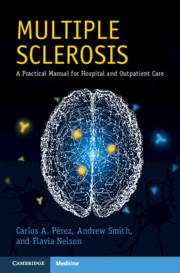Book contents
- Multiple Sclerosis
- Multiple Sclerosis
- Copyright page
- Contents
- Preface
- Chapter 1 Autoimmune CNS Emergencies
- Chapter 2 Clinical Features of Multiple Sclerosis
- Chapter 3 Multiple Sclerosis Phenotypes
- Chapter 4 Diagnostic Evaluation
- Chapter 5 Differential Diagnosis
- Chapter 6 Neuroimaging in Multiple Sclerosis and Its Mimics
- Chapter 7 Disease-Modifying Therapies
- Chapter 8 Treatment Goals
- Chapter 9 Symptomatic Management
- Chapter 10 Reproductive Issues
- Chapter 11 Pediatric Multiple Sclerosis
- Chapter 12 Useful Websites
- Appendices
- Index
- Plate Section (PDF Only)
- References
Chapter 11 - Pediatric Multiple Sclerosis
Published online by Cambridge University Press: 10 February 2021
- Multiple Sclerosis
- Multiple Sclerosis
- Copyright page
- Contents
- Preface
- Chapter 1 Autoimmune CNS Emergencies
- Chapter 2 Clinical Features of Multiple Sclerosis
- Chapter 3 Multiple Sclerosis Phenotypes
- Chapter 4 Diagnostic Evaluation
- Chapter 5 Differential Diagnosis
- Chapter 6 Neuroimaging in Multiple Sclerosis and Its Mimics
- Chapter 7 Disease-Modifying Therapies
- Chapter 8 Treatment Goals
- Chapter 9 Symptomatic Management
- Chapter 10 Reproductive Issues
- Chapter 11 Pediatric Multiple Sclerosis
- Chapter 12 Useful Websites
- Appendices
- Index
- Plate Section (PDF Only)
- References
Summary
Recognition and diagnosis of pediatric multiple sclerosis (MS) can be challenging given the broad differential of possible MS mimics and acquired demyelinating syndrome (ADS) phenotypes. It is not uncommon for clinicians to consider alternative diagnoses rather than MS in children with acute neurologic symptoms and white matter lesions on MRI, such as leukodystrophies, vasculopathies, mitochondrial defects, or other metabolic or inflammatory disorders. Once a diagnosis is made, the current lack of understanding regarding the safety and generalizability of use of disease-modifying therapy (DMT) in children can pose additional challenges to treating children and adolescents. In this chapter, we discuss the clinical presentation, diagnostic evaluation, and treatment approach to pediatric-onset MS, paying special attention to the areas in which pediatric disease may differ from adult-onset MS.
- Type
- Chapter
- Information
- Multiple SclerosisA Practical Manual for Hospital and Outpatient Care, pp. 193 - 210Publisher: Cambridge University PressPrint publication year: 2021



